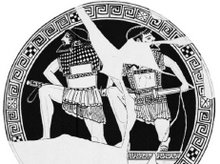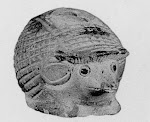
Last fall I published an article in the magazine Ancient Warfare on the Greek hoplite shield: "The Aspis: Surviving Hoplite Battle." If you have not seen this magazine, follow the link at right and take a look. Things have been quiet around here because I did not want to step on the article by posting too much online. Now I am going to examine the features of the aspis in detail and show how it allowed the Greeks to engage in a form of combat that they taken to an unique extreme. In a prior post (see last August's posts) I refuted the argument, put forward best by Adrian Goldsworthy, that Greek hoplites did not enter a mass pushing match, the othismos. In his paper he said the following which marks a perfect jumping-off point for this post:
“Should it be proved that the othismos really was a contest of massed shoving…It would be necessary to explain how the Greeks were able to fight in this unique way, and why they did so.” (Goldsworthy, A. K.: The Othismos, Myths and Heresies: The Nature of Hoplite Battle, War in History 4/1, 1997, 1-26.)

Nick Sekunda, in his Osprey title on hoplites, describes an Etruscan example in the Museo Gregoriano of the Vatican that appears similar to Greek examples. It was constructed of 20-30 cm poplar wood planks glued together horizontally to form a solid block, then turned on a lathe to form the characteristic shallow dome shape that left the flattened center of the core thinner than the curving outer edges. This shield has a diameter of 82cm, a depth of 10 cm and a 4.5 cm off-set rim reinforced with wooden laminates. The shield’s inner face was usually covered with leather and sometimes highly decorated. The face of the Vatican shield is covered in a seamless 0.5 mm layer of bronze that overlaps the inner face of the rim by 4 cm. This fully bronze-faced front of the shield is commonly portrayed, but archaeological finds show that bronze plating of the rim alone, perhaps with a bronze blazon, was more common.

This peculiar shield’s evolution is not well understood. Round, bronze-faced shields were common in the region prior to its appearance, but these were generally single-grip and did not display the twin features of domed shape and off-set rim. Assyrian infantry (below) carried large, deeply convex shields of bronze, but they had a single, central, grip and were cone-shaped. Urartian bronze shields, which have been excavated at Toprakkale near Lake Van in Anatolia, were domed with offset rims. Their diameter, 77 cm to 1 m, differed little from hoplite shields. These had a triple-grip system that has been interpreted to be a single hand grip and two points of attachment for a neck strap or telamon, but may have influenced Greek design.

“Should it be proved that the othismos really was a contest of massed shoving…It would be necessary to explain how the Greeks were able to fight in this unique way, and why they did so.” (Goldsworthy, A. K.: The Othismos, Myths and Heresies: The Nature of Hoplite Battle, War in History 4/1, 1997, 1-26.)
The answer to Goldsworthy’s challenge lies in understanding the hoplite shield. It is often referred to as a hoplon, but the term hoplon can refer to any implement of war. The specific term for shield is aspis and the shield we are concerned with is known as the Argive aspis, although the connection to Argos, either as originator or mass-producer, is unclear.

Before showing what it does, I must describe what it is. In this first post I will discuss its construction and characteristic features. The shield may have originated as early as the late 8th or early 7th century B.C. and survived in nearly identical form for at least three hundred years. Round to slightly oval in outline, normally 80 cm to 1 m in diameter and about approximately 7.5 kg weight, its characteristic features are a convex profile and a robust, offset outer rim.
Nick Sekunda, in his Osprey title on hoplites, describes an Etruscan example in the Museo Gregoriano of the Vatican that appears similar to Greek examples. It was constructed of 20-30 cm poplar wood planks glued together horizontally to form a solid block, then turned on a lathe to form the characteristic shallow dome shape that left the flattened center of the core thinner than the curving outer edges. This shield has a diameter of 82cm, a depth of 10 cm and a 4.5 cm off-set rim reinforced with wooden laminates. The shield’s inner face was usually covered with leather and sometimes highly decorated. The face of the Vatican shield is covered in a seamless 0.5 mm layer of bronze that overlaps the inner face of the rim by 4 cm. This fully bronze-faced front of the shield is commonly portrayed, but archaeological finds show that bronze plating of the rim alone, perhaps with a bronze blazon, was more common.
Wicker was another possibility for early shields, and into the classical period bronze shield-rims often display a characteristic Guilloche style that is a stylized woven pattern. This may hearken to a time when the shield itself was woven.

The aspis was supported by a double-grip system. Near the center of the shield’s concave interior was a bronze loop, the porpax, through which the left forearm was placed to bear the weight of the shield. The porpax was secured to the shield’s inner face by long vertical bronze straps. This structure could be one piece or made so that the armband was removable, as the Spartans are said to have done to render their shields unusable to rebellious Helot serfs. A second grip, the antilabe, was for the left hand and was placed near the rim. The grip was a pair of metal staples through which a rope passed that traveled through four or more metal rings spaced around the inside perimeter of the shield.
This peculiar shield’s evolution is not well understood. Round, bronze-faced shields were common in the region prior to its appearance, but these were generally single-grip and did not display the twin features of domed shape and off-set rim. Assyrian infantry (below) carried large, deeply convex shields of bronze, but they had a single, central, grip and were cone-shaped. Urartian bronze shields, which have been excavated at Toprakkale near Lake Van in Anatolia, were domed with offset rims. Their diameter, 77 cm to 1 m, differed little from hoplite shields. These had a triple-grip system that has been interpreted to be a single hand grip and two points of attachment for a neck strap or telamon, but may have influenced Greek design.

In the next post I will discuss the function of this dome-shaped shield.






4 comments:
Thanks for the details - do you have a source for your measurements of the Vatican shield?
Indeed I do have the report on this shield. Email me.
Was the antilabe/rope configuration a kind of simple suspension/shock absorbtion? When the rim of the shield is jostled (e.g, by the adjacent person's shield) the rope might stretch/move slightly, meaning the force isn't directly transferred to the hand. Equally for the shoulder - if the shield's lip rests on the rope, which rests on the shoudler.
Post a Comment